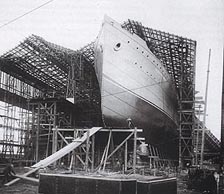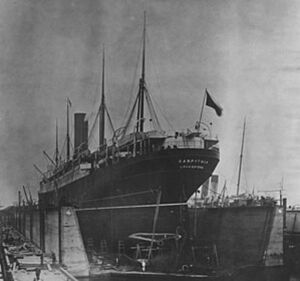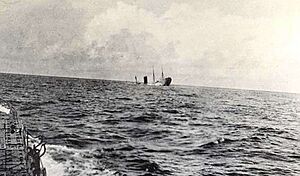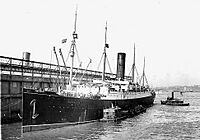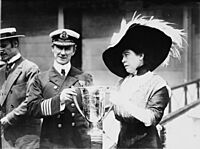RMS Carpathia facts for kids
class="infobox " style="float: right; clear: right; width: 315px; border-spacing: 2px; text-align: left; font-size: 90%;"
| colspan="2" style="text-align: center; font-size: 90%; line-height: 1.5em;" | 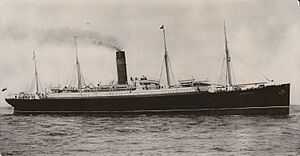
|}
The RMS Carpathia was a large passenger steamship owned by the Cunard Line. It was built in England by Swan Hunter & Wigham Richardson. The ship's name came from the Carpathian Mountains in Central Europe.
The Carpathia began its first journey in 1903. It sailed from Liverpool to Boston. Later, it was moved to routes in the Mediterranean Sea.
In April 1912, the Carpathia became very famous. It rescued survivors from the RMS Titanic. The Titanic had hit an iceberg and sank in the North Atlantic Ocean. The Carpathia sailed through ice to reach the area. Its crew saved 705 people from the Titanic's lifeboats.
During World War I, the Carpathia was sunk. A German submarine, U-55, hit it with three torpedoes. This happened on July 17, 1918, off the coast of Ireland. Five crew members sadly lost their lives.
Contents
| History | |
|---|---|
| Name | RMS Carpathia |
| Namesake | Carpathian Mountain Range |
| Owner | Cunard Line |
| Port of registry | Liverpool |
| Route |
|
| Builder | C.S. Swan & Hunter, Wallsend, England |
| Yard number | 274 |
| Laid down | 10 September 1901 |
| Launched | 6 August 1902 |
| Completed | February 1903 |
| Maiden voyage | 5 May 1903 |
| In service | 1903–1918 |
| Out of service | 17 July 1918 |
| Identification |
|
| Fate | Sunk by three torpedoes from SM U-55 on 17 July 1918 |
| Notes | Famous for rescuing 712 survivors from the sinking of RMS Titanic in 1912 |
| General characteristics | |
| Type | Ocean liner |
| Tonnage | 13,603 GRT, 8,660 NRT |
| Length | 558 ft (170 m) |
| Beam | 64 ft 6 in (19.66 m) |
| Draught | 34 ft 7 in (10.54 m) |
| Decks | 7 |
| Propulsion |
|
| Speed |
|
| Capacity |
|
- Service in World War I
- The Sinking of the Carpathia
- Finding the Wreck
- Images for kids
- Gallery
- See also
Building the Carpathia
How the Ship was Designed
Around 1900, the Cunard Line faced tough competition. Other big shipping companies like White Star Line had faster and larger ships. Cunard decided to build new ships that were more cost-effective. They wanted to save money on fuel.
The Carpathia was one of these new ships. It was designed to carry many immigrant travelers. It was not built for speed like some other famous liners. Its design helped Cunard compete with bigger rivals.
The Carpathia was about 40 feet (12 m) shorter than its "half-sisters," the Ivernia and Saxonia. It had a long body and a low, balanced upper structure. It also had four masts with cranes. These cranes helped load and unload a lot of cargo.
Construction and Features
The Carpathia was built by C. S. Swan & Hunter in Wallsend, England. Its construction started on September 10, 1901. The ship was launched on August 6, 1902. Miss Watson, whose father was a Cunard vice-chairman, christened the ship.
The Carpathia was 558 ft (170 m) long and 64 ft 3 in (19.58 m) wide. It weighed over 13,500 tons when finished. The ship had four steel decks and a bridge deck for passengers.
At first, it was planned to carry 200 first-class and 600 third-class passengers. It could also carry a lot of frozen meat. When completed, its capacity grew to about 1,700 passengers.
Inside the Ship
Even though it was an "intermediate" liner, the Carpathia was very comfortable. Its dining room was decorated in cream and gold. It had a stained-glass dome and electric fans for fresh air.
Second-class passengers had a nice smoking room and a library. After 1905, these areas became first-class. Third-class areas were very good for the time. Their dining room could seat 300 people. It had polished oak walls. Third-class also had a smoking room and a ladies' room.
The ship had good ventilation with fans and special heating/cooling systems. It had over 2,000 electric lamps. There were also backup oil lamps in case of power cuts.
The Carpathia used steam engines for power. These engines allowed it to travel at about 14 kn (16 mph; 26 km/h).
The Carpathia made its first journey on May 5, 1903. It sailed from Liverpool to Boston. It also served routes between New York City and Mediterranean ports. These ports included Gibraltar, Algiers, Genoa, Naples, Trieste, and Fiume.
Ship's Life and Changes
Early Journeys and Upgrades
The Carpathia was known for being comfortable, especially in rough seas. This was because of its wide design and special balancing parts. It was popular with both tourists and people moving to new countries.
In summer, it sailed between Liverpool and New York City. In winter, it went from New York City to the Mediterranean Basin.
In 1904, Cunard partnered with a Hungarian shipping company. The Carpathia then started carrying Hungarian immigrants. Because of this, it was updated in 1905. Its passenger capacity increased from 1,700 to 2,550. Small third-class cabins became larger shared rooms. Some second-class areas became first-class.
By 1912, the ship could carry 2,450 passengers. This included 250 first and second-class passengers. It had a crew of about 300 people. The ship also carried 20 lifeboats.
The Carpathia Rescues Titanic Survivors
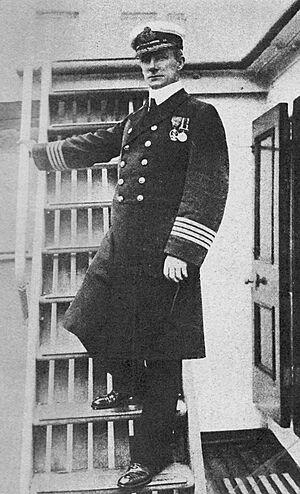
On April 11, 1912, the Carpathia left New York City. It was heading to Fiume, Austria-Hungary (now Rijeka, Croatia). There were about 240 crew members and 743 passengers on board.
On the night of April 14, the Carpathia's wireless operator, Harold Cottam, was about to go to bed. He heard a message for the Titanic from Cape Cod. He decided to help and sent a message to the Titanic.
At 12:11 a.m. on April 15, he received a shocking reply. It was the Titanic's distress signal. The message said they had hit an iceberg and needed urgent help.
Cottam quickly told Captain Arthur Henry Rostron. Captain Rostron was at first unsure. But once he understood the seriousness, he acted fast. He ordered the ship to turn around. He also told the chief engineer to make the ship go as fast as possible.
The Titanic was about 58.22 nmi (67.00 mi; 107.82 km) away. It took the Carpathia three and a half hours to get there. By then, the Titanic had already sunk.
Captain Rostron prepared for the rescue. He turned off the ship's heating to make more steam for the engines. He put extra lookouts to spot icebergs. Doctors were ready in the dining rooms. Blankets, ladders, and mail sacks were prepared for the survivors.
The Carpathia reached the ice field by 2:45 a.m. For two hours, it carefully dodged icebergs. At 4:00 a.m., the Carpathia arrived at the Titanic's last known position. The Titanic had sunk about an hour and a half earlier, with 1523 lives lost.
For the next four and a half hours, the Carpathia rescued 705 survivors. They were picked up from the Titanic's lifeboats. Carpathia passengers helped by offering food, drinks, and comfort. By 9:00 a.m., all survivors were on board. Captain Rostron then ordered the ship to leave the area.
Captain Rostron decided to take the survivors to New York City. News of the disaster spread quickly. The Carpathia became the focus of media attention. Captain Rostron ordered that no news be sent directly to the press.
The Carpathia arrived in New York on the evening of April 18, 1912. It was raining heavily. The ship first docked at the White Star Line pier. There, it unloaded the Titanic's 13 lifeboats. Then, it moved to the Cunard pier to let the survivors off.
The Carpathia crew received many medals for their rescue work. Captain Rostron received a silver cup and a gold medal from Margaret Molly Brown. He was also honored by King George V and President William Howard Taft. He received the Congressional Gold Medal, a very high honor in the US.
A waiter from the Carpathia, Josip Car, kept a Titanic life jacket. He donated it in 1938. It is one of only 14 known original Titanic life jackets. It is the only one displayed in Europe.
A place in the ocean, Carpathia Seamount, is named after the ship. This is because of its role in the Titanic disaster.
Service in World War I
During World War I, the Carpathia helped transport soldiers. It carried Canadian and American Expeditionary Forces to Europe. It often sailed in groups of ships called convoys. These convoys helped protect ships from submarine attacks.
At some point, the ship's red funnel was painted gray. Later, the whole ship was painted in dazzle camouflage. This made it harder for enemy submarines to spot.
The Sinking of the Carpathia
On July 15, 1918, the Carpathia left Liverpool. It was in a convoy heading to Boston. It had 57 passengers and 166 crew members. The convoy sailed in a zig-zag pattern to avoid submarines.
On July 17, the convoy's escort left. The Carpathia continued with six other ships. It was the largest ship, so it led the convoy. At 9:15 a.m., a torpedo was seen approaching the ship.
The crew tried to avoid it, but it was too late. The Carpathia was hit by a torpedo from the German submarine SM U-55. It was hit near the middle of the ship. A second torpedo hit the engine room. This killed five crew members and stopped the engines. The explosions also damaged the ship's radio and two lifeboats.
Captain William Prothero, who commanded the Carpathia since 1916, ordered the other ships to send wireless messages using flags. He also fired rockets to get attention from nearby patrol boats. The rest of the convoy quickly sailed away.
The Carpathia began to sink by its front end and lean to one side. Captain Prothero gave the order to abandon ship. All passengers and surviving crew got into the 11 lifeboats. There were 218 survivors out of 223 people on board.
Captain Prothero and some officers stayed on the ship. They made sure important documents were thrown overboard. Then, they got into a lifeboat. The U-55 surfaced and fired a third torpedo. This caused a huge explosion that sealed the Carpathia's fate.
The U-55 started to approach the lifeboats. But then, a British warship, HMS Snowdrop, arrived. It fired at the submarine, driving it away. The Snowdrop then picked up the survivors from the Carpathia around 1:00 p.m. The Snowdrop returned to Liverpool with the survivors on July 18.
The Carpathia sank at 11:00 a.m. It went down about 1 hour and 45 minutes after the first torpedo hit. Its location was about 120 mi (190 km) west of Fastnet Rock. The Carpathia was the fifth Cunard ship sunk in just five weeks.
Finding the Wreck
On September 9, 1999, news agencies reported that the Carpathia's wreck had been found. It was thought to be in 600 ft (180 m) of water, 185 mi (298 km) west of Land's End. However, this turned out to be another ship, the Isis.
In 2000, American author and diver Clive Cussler announced his team had found the real Carpathia. They found it in the spring of that year, at a depth of 500 ft (150 m). The ship was found sitting upright on the seabed. Its location is about 120 mi (190 km) west of Fastnet Rock, Ireland.
The wreck of the Carpathia is now owned by Premier Exhibitions Inc. This company plans to recover items from the ship.
Images for kids
Gallery
-
Margaret Brown (right) giving Captain Arthur Henry Rostron a golden award for his service in the rescue of the Titanic's survivors
See also
 In Spanish: RMS Carpathia para niños
In Spanish: RMS Carpathia para niños
- SS Californian, another vessel that was involved with the Titanic and sank in the First World War
- SS Mount Temple, another vessel that was initially thought to be the "mystery ship" failing to respond to the Titanic's distress calls


